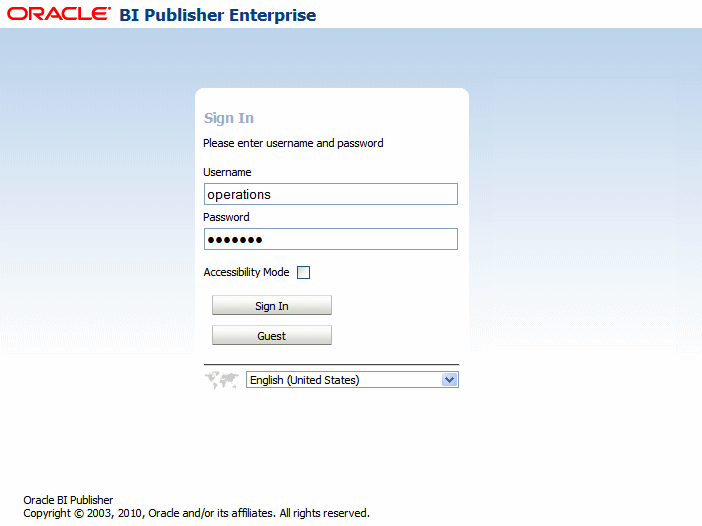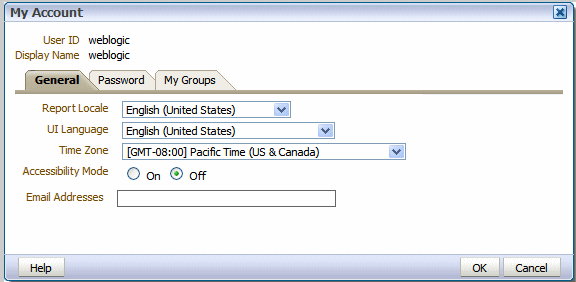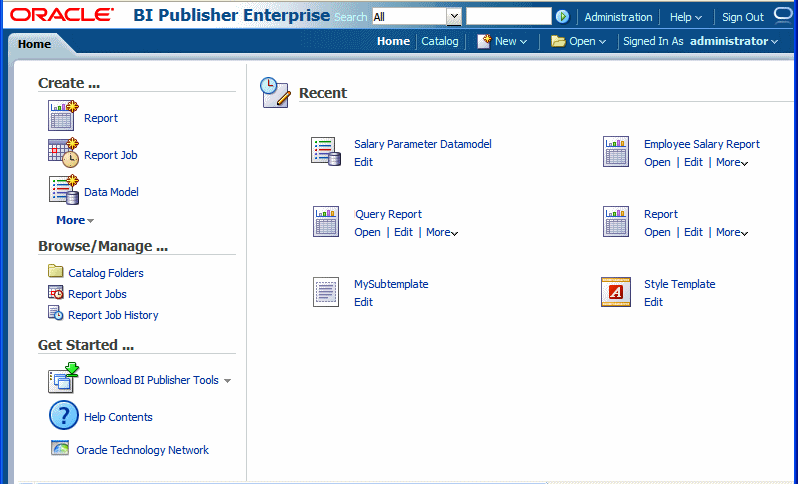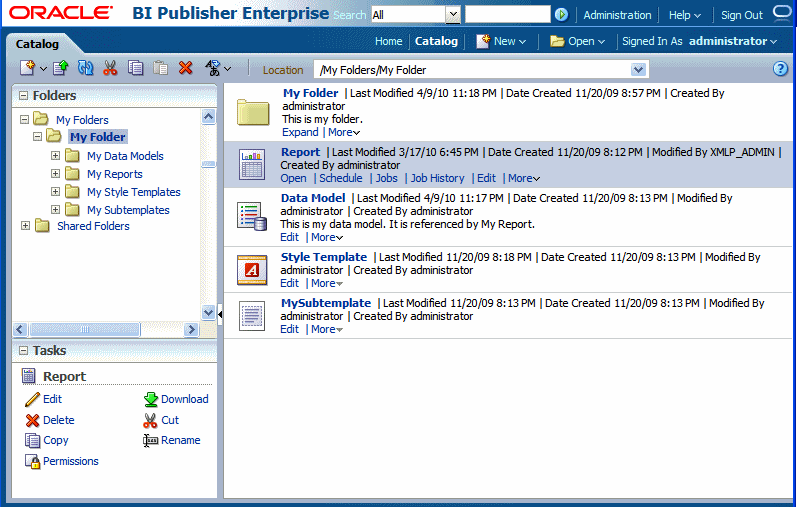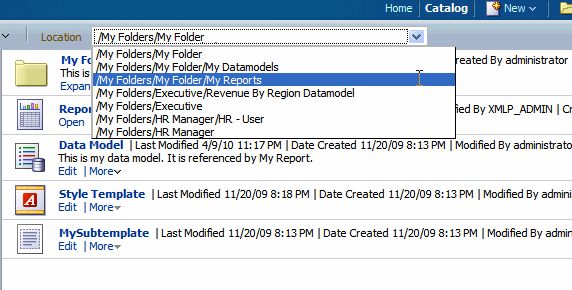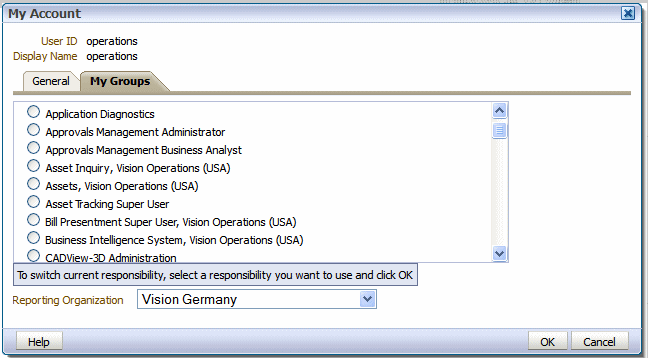2 Getting Started
This chapter describes basic features of the BI Publisher application including setting preferences, navigating the catalog, and accessing task menus.
This chapter includes the following sections:
-
Section 2.1, "Accessing Oracle Business Intelligence Publisher"
-
Section 2.2, "Setting My Account Preferences and Viewing My Groups"
Note:
If your implementation of BI Publisher is integrated with Oracle Business Intelligence Enterprise Edition (BI EE), you will most likely access BI Publisher through the Oracle BI EE application. For information on the BI Publisher features in the Oracle BI EE interface, see "Introducing Oracle Business Intelligence Enterprise Edition" in Oracle Fusion Middleware User's Guide for Oracle Business Intelligence Enterprise Edition.
2.1 Accessing Oracle Business Intelligence Publisher
You can access BI Publisher in the following ways:
2.1.1 Logging in with Credentials
To log in with credentials:
-
Navigate to the URL provided by your administrator (for example: http://example.com:9704/xmlpserver), as shown in Figure 2-1.
-
Select the language that you prefer for log in page. Your language selection only remains in effect for the current session of BI Publisher. The next time you log into BI Publisher, the original default language is displayed.
The log in page language selection does not take effect on any other pages in BI Publisher. For more information on setting the overall BI Publisher UI Language, see Section 2.2.2, "Setting General Preferences."
If your implementation of BI Publisher is integrated with Oracle Business Intelligence Enterprise Edition (BI EE), you cannot modify the language selection on the log in page.
-
Enter your credentials to sign in to BI Publisher.
-
Click Sign In.
Note:
For information about Accessibility Mode see Section 2.2.2.4, "Accessibility Mode.".
-
To view reports, see Section 3.1, "About Viewing Reports in BI Publisher."
-
To set user preferences, see Section 2.2, "Setting My Account Preferences and Viewing My Groups."
-
To view reports, see Section 3.1, "About Viewing Reports in BI Publisher."
-
To browse the catalog, see Section 2.4.1, "Browsing the Catalog."
-
To schedule reports, see Section 4.1, "Navigating to the Schedule Report Job Page."
2.1.2 Logging in as Guest
If your administrator has enabled guest access, then a Guest button displays on the login page.
A guest user does not require credentials and has privileges only to view reports available in the folder set up for guest access.
To log in as a guest:
-
Select the language you prefer for the user interface.
-
Click Guest.
2.2 Setting My Account Preferences and Viewing My Groups
Use the My Account dialog to:
-
Set general preferences
-
Change your password
-
View assigned roles
Note:
Your preferences may be inherited from another Oracle product. If this is true for your work environment, you cannot update your preferences from within BI Publisher. If you are not sure where to update your preferences, ask your administrator.
When BI Publisher is integrated with Oracle Business Intelligence Enterprise Edition (BI EE), the Report Locale, UI Language, and Time Zone user preferences are set in the Oracle BI EE application. For more information, see "Setting Preferences" in Oracle Fusion Middleware User's Guide for Oracle Business Intelligence Enterprise Edition. When you update your BI Publisher preferences in Oracle BI EE, you must start a new BI Publisher HTTP session for these to take effect in the BI Publisher interface.
2.2.1 To Access the My Account dialog:
-
In the global header, click your user name displayed after Signed In As and then select My Account as shown in Figure 2-2.
The My Account dialog is shown in Figure 2-3.
2.2.2 Setting General Preferences
Use the General tab to set the following options:
-
Note:
The Email Addresses field is reserved for future use and is not functional in this release.
2.2.2.1 Report Locale
A locale is a language and territory combination (for example, English (United States) or French (Canada)). BI Publisher uses the report locale selection to determine the following:
-
The translation to apply to a report layout
-
The number, date, and currency formatting to apply to the report data
If a particular report does not have a translation for the selected locale, BI Publisher applies a locale fallback logic to select the most appropriate layout available. For more information, see "Locale Selection Logic" in Oracle Fusion Middleware Report Designer's Guide for Oracle Business Intelligence Publisher.
BI Publisher applies localized number, date, and currency formatting independently of the layout translation.
2.2.2.2 UI Language
The UI language is the language in which the user interface displays, and you select languages that are available for your installation.
If your implementation of BI Publisher is integrated with Oracle Business Intelligence Enterprise Edition (BI EE), you cannot change the UI language here. For more information, see "Setting Preferences" in Oracle Fusion Middleware User's Guide for Oracle Business Intelligence Enterprise Edition.
2.2.2.3 Time Zone
Reports display the time according to the time zone preference selected here. You can override this setting when creating a scheduled report job, as described in Chapter 4, "Creating Report Jobs." Note that the time displayed on the user interface and reflected in report processing times is governed by the BI Publisher server time zone.
2.2.2.4 Accessibility Mode
Setting this to "On" enables features of the BI Publisher user interface to enhance accessibility for users who interact with BI Publisher using the keyboard only.
With Accessibility Mode on, the following features are enabled:
-
Tables on user interface pages display checkboxes to enable multi-row selection and subsequent action.
-
Menus can be accessed with assistive technology.
-
"Skip to content" is enabled. When tabbing into the main page of the application, the first item you tab to is a special field that states "Skip to content." When you press the Enter key with focus on this item, the focus skips over the header links to the main body of the page. For example, if you are on the Home Page and you tab to "Skip to content" and press Enter, you are advanced to the Create region with focus on Report. The focus skips over Search, Help, Sign Out, and other links in the global header.
-
The create report process flow limits the options presented to require the selection of a data model as the first step in the process.
-
The Administration link is not displayed.
2.2.3 Changing Your Password
To change your password, click the Password tab of the My Account dialog.
If your account password settings are inherited from another application, then you cannot update your password here.
2.3 About the Home Page
The Oracle BI Publisher Home page provides an intuitive, task-based entry into Oracle BI Publisher's functionalities. The Home page is divided into sections that enable you to quickly begin a specific task, locate an object, or access documentation. Figure 2-4 shows the Home page.
The Home page consists of the following sections:
2.3.1 Create
The Create section provides links to initiate creation tasks, such as create report, create report job and create data model. Click More to access options not shown. BI Publisher populates this list based on the permissions or roles you have.
For more information on each task, see the documents that are listed in Table 2-1.
Table 2-1 Lists of Tasks and Documents
| Task | More Information |
|---|---|
|
Create Report |
"Creating and Editing Reports" in Oracle Fusion Middleware Report Designer's Guide for Oracle Business Intelligence Publisher |
|
Create Report Job |
|
|
Create Data Model |
"Using the Data Model Editor" in Oracle Fusion Middleware Data Modeling Guide for Oracle Business Intelligence Publisher |
|
Create Style Template |
"Creating and Implementing Style Templates" in Oracle Fusion Middleware Report Designer's Guide for Oracle Business Intelligence Publisher |
|
Create Subtemplate |
"Understanding Subtemplates" in Oracle Fusion Middleware Report Designer's Guide for Oracle Business Intelligence Publisher |
2.3.2 Browse/Manage
The Browse/Manage section provides quick access to the catalog, where you can browse and manage reports and other catalog objects; and to the Report Jobs and the Report Jobs History pages, where you can view and manage scheduled, running, and completed report jobs.
2.3.3 Get Started
The Get Started section contains the following links:
-
Download BI Publisher Tools
This list contains additional products that you can download and install.
-
BI Publisher Desktop (32 bit or 64 bit)
BI Publisher Desktop includes:
-
Template Builder for Microsoft Word
-
Template Builder for Microsoft Excel
-
Template Viewer
This add-in for Microsoft Word facilitates the design of RTF templates. For more information, see "Creating RTF Templates Using the Template Builder for Word" in Oracle Fusion Middleware Report Designer's Guide for Oracle Business Intelligence Publisher.
The Template Builder for Excel is included in the Template Builder for Word installation. The Template Builder for Excel is an add-in for Microsoft Excel that facilitates the design of Excel Templates. For more information, see "Creating Excel Templates" in Oracle Fusion Middleware Report Designer's Guide for Oracle Business Intelligence Publisher.
The Template Viewer enables the testing of most template types from your desktop.
-
-
Analyzer for Excel
This add-in for Microsoft Excel enables you to manipulate the results of a report query in Excel and also to upload a spreadsheet back to BI Publisher to use as a layout. For more information, see Section 3.7, "Using the Analyzer for Excel."
-
Oracle SQL Developer
Oracle SQL Developer is a free and fully supported graphical tool for database development. With SQL Developer, you can browse database objects, run SQL statements and SQL scripts, and edit and debug PL/SQL statements. You can also run any number of provided reports, as well as create and save your own. SQL Developer enhances productivity and simplifies your database development tasks.
-
-
Help Contents
Opens the Help table of contents.
-
Oracle Technology Network
Accesses the Oracle Technology Network (OTN) to search for technical articles about Oracle products, participate in discussions about Oracle products, ask the user community technical questions, and search for and download Oracle products.
2.3.4 Recent
The Recent section contains the reports and other objects that you have recently viewed, created, or updated. You can take actions on these objects directly from the Recent region; for example, you can open, edit, schedule, and view jobs or job history for a report.
Note:
When BI Publisher is integrated with Oracle BI Enterprise Edition, this region is updated only when the BI Publisher objects are accessed from the Oracle BI EE interface.
2.3.5 Favorites
The Favorites region enables you to create your own list of objects for quick access. From the Favorites region you can view, schedule, configure, or edit the objects that you place there (providing you also have proper permissions). There are several ways to add objects to the Favorites region:
-
Locate the object in the catalog, click the More link, and then click Add to Favorites
-
From the Report Viewer, click the Actions menu, and then click Add to Favorites
-
Use the Manage link on the Home page to add reports
To add and delete reports from the Favorites region using the Manage link:
Click the Manage link to open the Favorites area for editing.
To add a report to Favorites:
-
Select the report in the catalog pane.
-
Drag the report to the Favorites region.
To delete an object from Favorites:
-
Locate the item and click the More link.
-
Click Remove.
2.4 About the Catalog
The catalog stores the BI Publisher objects, such as reports, data models, and style templates. Figure 2-5 shows the Catalog page.
Use the Catalog page to locate objects in the catalog and perform tasks specific to those objects. The objects and options that are available to you are determined by your system privileges and the permissions assigned to individual folders and objects.
The Catalog page can also be used to perform more specialized tasks such as:
-
Setting object-level permissions
-
Downloading and uploading objects
-
Exporting and importing catalog translations
For more information about the functions you can perform in the catalog, see Section 7.1, "Overview of the Catalog."
2.4.1 Browsing the Catalog
Use the Folders pane of the Catalog page to display and navigate the content of personal (My Folders) and shared folders that all users can access. Select a folder to view its contents in the display area.
2.4.2 Using the Location Bar to Find Your Place and Navigate Back
The Location bar displays your current location within the catalog directory structure. The Location bar also maintains catalog locations that you have visited while in your current catalog session.
To navigate back to a folder you previously visited in this session, click the arrow on the Location bar to open the list of locations as shown in Figure 2-6.
2.5 About the Global Header
The global header, shown in Figure 2-7, contains links and options that enable you to quickly begin a task or locate a specific object within BI Publisher. Many of the options that are available from the global header are also available within the Home page.
The global header is always displayed when you are working in BI Publisher. When you are viewing a report or working within one of the task editors, you can use the global header to quickly begin a new task, search the catalog, access product documentation, or view a different object.
The Signed In As area enables you to access the My Account dialog, where you can specify your preferences. For more information, see Section 2.2, "Setting My Account Preferences and Viewing My Groups."
If you are logged in as an administrator, the Administration link is displayed in the global header to enable access to the Administration page. For more information about the tasks on the Administration page, see "About the Administration Page" in Oracle Fusion Middleware Administrator's Guide for Oracle Business Intelligence Publisher.
2.6 Searching the Catalog
Use the global header search feature to quickly locate an object by type and name from anywhere in the catalog.
From the Search menu, select the object type and enter all or part of the object's name in the search field. Click the Search button to display the results that match your criteria.
From the results page you can select and perform an action on an object from the results, filter the search results, or start a new search.
2.7 For Oracle E-Business Suite Users: Switching Responsibilities and Reporting Organization
If BI Publisher is integrated with Oracle E-Business Suite security, you can switch responsibilities as follows:
-
In the global header, click your user name displayed after Signed In As and then select My Account.
-
Click My Groups to view the list of responsibilities and your reporting organization, as shown in Figure 2-8.
-
To change your current responsibility, select a new responsibility from the list. To change your reporting organization, select it from the Reporting Organization menu and click OK.
